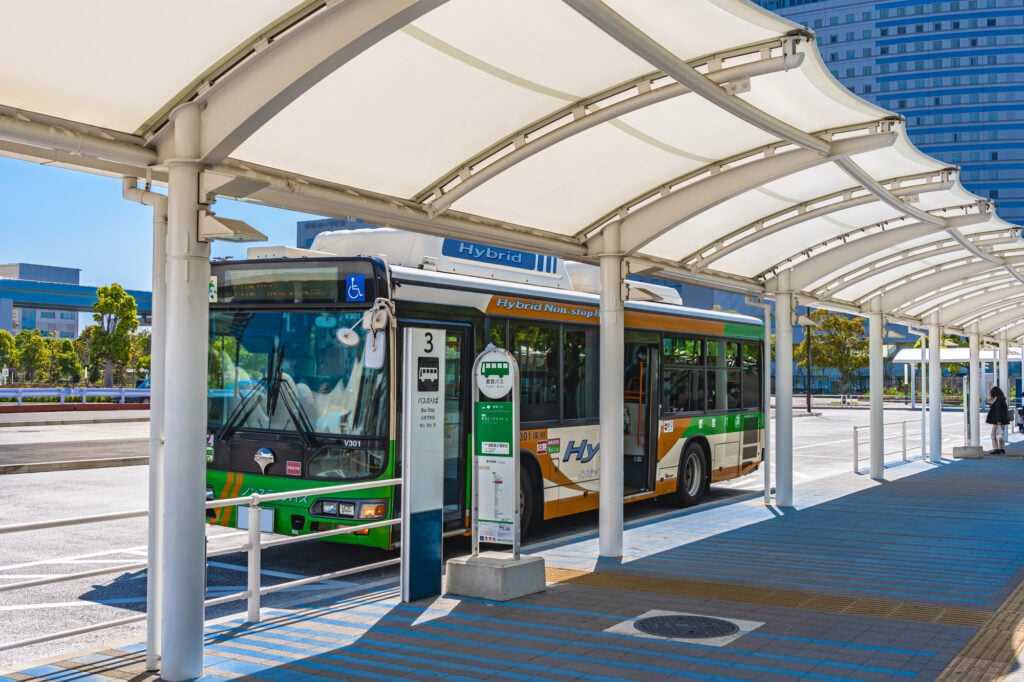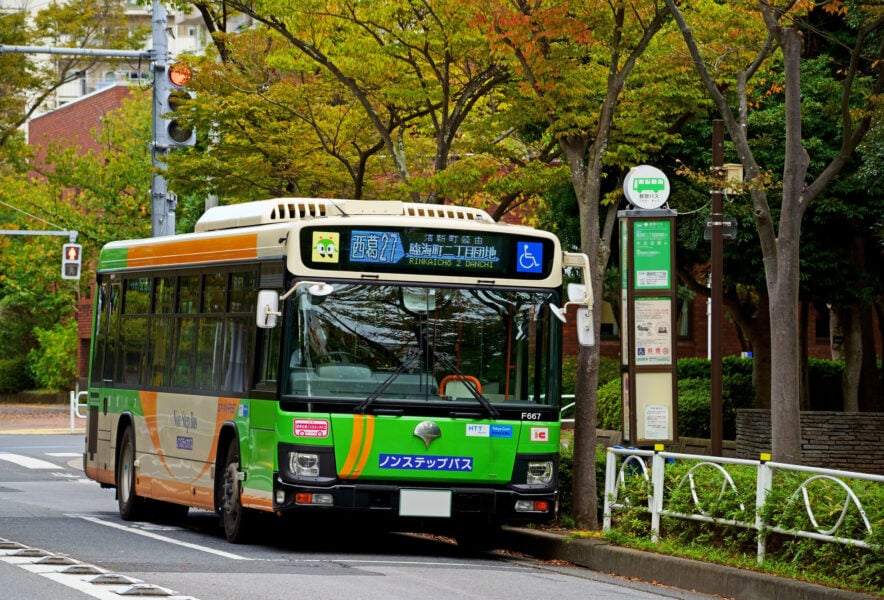Tokyo's Toei (都営; meaning "operated by the Tokyo Metropolitan Government") buses are very convenient for getting around in Tokyo, as they cover all of the 23 wards of the city and run every 5 to 10 minutes on major routes.
The fares are uniform, and at 210 yen (IC 210 yen) for adults and 110 yen (IC 105 yen) for children, the fares are cheaper than those of the Toei Subway and other subway services.
When traveling within the 23 wards of Tokyo, be sure to take a Toei bus.
This article provides an easy-to-understand explanation of how to ride the Toei buses in Tokyo.
Pay upon entry for all Toei buses in Tokyo's 23 wards

All Toei buses in the 23 wards of Tokyo use a pay-upon-entry system.
Boarding the bus from the front door, passengers insert cash or touch their IC card into the fare box. When getting off, the rule is to exit through the middle or rear door.
Thus, in principle, Toei buses require passengers to board and pay in advance when boarding and to alight from the back of the bus when exiting, thereby facilitating boarding and alighting and preventing delays.
Payment methods for Toei buses in the 23 wards of Tokyo
1. Cash
- Coins
- 1,000 yen bills
2. IC card
- PASMO
- Suica
- Kitaca
- manaca
- TOICA
- PiTaPa
- ICOCA
- Hayakaken
- nimoca
- SUGOCA
- Apple Pay PASMO, Mobile PASMO, Mobile Suica
As mentioned above, cash and IC cards can be used for payment on Toei buses operating in the 23 wards of Tokyo.
When paying with paper money, please note that 5,000 yen and 10,000 yen bills are not accepted.
The fare for Toei buses within the 23 wards of Tokyo is 210 yen for adults (IC 210 yen) and 110 yen for children (IC 105 yen).
How to Ride a Toei Bus in Tokyo's 23 Wards
To board a Toei bus operating within the 23 wards of Tokyo, follow the steps below.
1. Check routes and bus stops
First, check the bus route and the bus stop to go to your destination.
Google Maps, Transfer Guide, and other applications are useful for finding routes and bus stops.
The Toei Bus website (https://www.kotsu.metro.tokyo.jp/bus/map/) also provides a list of bus routes and bus stop information (Minkuru Guide).
2. Wait for the bus at the bus stop
Once you know the bus route and bus stop for your destination, go to the bus stop and wait for the bus.
When you arrive at the bus stop, check the bus stop sign and confirm the bus number assigned to each destination.
The bus stop sign also indicates the estimated time of arrival of the bus.
3. Board through the front door and pay the fare
When the bus with the number you need to board arrives, board through the front door of the bus.
When boarding, insert cash into the fare machine or touch your PASMO or other IC card.
Place the IC card horizontally against the card reader of the fare machine.
If the card is read correctly, you will hear a short “beep”.
Conversely, if the IC card cannot be read, a repetitive error "beep" will be heard. If this happens, try touching the IC card again.
4. Press the "get off" button
When the next bus stop is the one you want to get off at, press the “get off” button.
For example, if the bus is going from Roppongi 1-chome Station followed by Roppongi 4 followed by Roppongi Station, and you want to get off at Roppongi Station, then press the "Get off" button when you pass Roppongi 4.
By pressing the “get off” button, the bus will stop at the next stop.
5. Get off the bus
When the bus stops, exit through the middle or rear door.
Rules and cautions for riding Toei buses
Below are the rules, cautions, and manners on how to ride a Toei bus.
Only coins and 1,000 yen bills are accepted as payment
Only coins and 1,000-yen bills are accepted for payment on Toei buses; 5,000-yen and 10,000-yen bills are not accepted and cannot be exchanged, so please have coins and 1,000-yen bills ready before boarding.
Old coins and bills, such as old 500-yen coins, cannot be read by the fare machines, so please have other coins and bills ready.
The fare machine on Toei buses automatically calculates the fare and returns the change when you insert an amount greater than the fare.
Therefore, when paying with multiple coins or bills, such as 10 yen + 500 yen or 10 yen + 1,000 yen, insert the smallest amount first.
By inserting 10 yen coins first, you can avoid collecting too much loose change.
What you can and cannot bring on a Toei bus
For safety reasons and to prevent inconvenience to other passengers, Toei buses have the following regulations on what you can and cannot bring on board.
Items that can be brought on board
- Personal effects: Items that do not exceed 250 cm in total length, width, and height, 2 m in length, and 30 kg in weight may be carried on board as personal effects. However, please note the following
- The total size of all personal effects brought into the cabin must be within the specified dimensions. All handheld items must be able to be held in one hand (i.e., the hand not holding the baggage must be able to hold onto a strap or handrail).
- Items with protrusions or wheels, such as bicycles, striders/kickboards, etc., must be secured in motion and stored in a special bag.
- Even if a hand-held item is within the specified size, we may ask visitors to refrain from bringing it in during busy times, and we may also restrict items that we deem to be a safety hazard.
- Pets: Except for guide dogs and service dogs, animals are not permitted in principle. However, small pet animals (pets) may be brought in only if they are fully cased so as not to disturb other guests.
- Baby strollers: Strollers may be brought into the car if they are folded up.
- Wheelchairs: May be placed in the wheelchair spaces provided in the car.
- Others: Umbrellas, walking sticks, musical instruments (in a case), sports equipment (ski boards, snowboards, etc.), etc., as long as they are of a size and shape that will not disturb other passengers.
Items that cannot be brought in
- Dead bodies: Dead bodies may not be brought in.
- Hazardous materials: Explosives, flammables, deleterious substances, poisonous substances, and other items known as hazardous materials may not be brought in.
- Hazardous materials: Pesticides, insecticides, paints, and other hazardous materials may not be brought into the building.
- Items that may block aisles, doors, or emergency doors: Large furniture, appliances, and other items that may block aisles, doors, or emergency doors may not be brought in.
- Items that may stain the vehicle: Clothing, shoes, paint cans, etc. that are soiled with mud or oil may not be brought in.
- Other: You may not bring in items that emit foul odors, make loud noises, or cause inconvenience to other passengers.
Other manners on Toei buses
Please observe the following manners when riding a Toei bus.
Smartphones should be on silent mode and refrain from talking on the phone
It is good manners to set your phone to silent mode and refrain from talking on it while in the car. Also, turn off your phone when you are near priority seats.
Give priority seats to those who need them
Priority seats in each car should be given to the elderly, the physically disabled, pregnant women, people with infants, and people with a help mark.
If there is no such person or if a seat is available, you may sit in the seat.

Incidentally, the Help Mark is a mark for people with illnesses or handicaps that are difficult to see from the outside.
They are carried by those who need assistance and care from their surroundings, such as those with artificial legs or joints, internal disabilities, intractable diseases, and early pregnancy.
If you see a person wearing the Help Mark, be considerate and considerate by offering your seat or assisting in evacuations in the event of a disaster.
No smoking at any time
Smoking is prohibited all day on Toei buses, both inside the buses and at bus stops.
Any activity that constitutes smoking, including electronic cigarettes and similar products, is prohibited.
Let's take a ride on a Toei bus!
Toei buses are low-cost, convenient buses that can take you anywhere in Tokyo's 23 wards.
Another point recommended for travelers is that you can enjoy various views of Tokyo from the bus windows.
We hope you will enjoy sightseeing in Tokyo on a Toei bus with reference to the riding style and manners introduced in this article.

